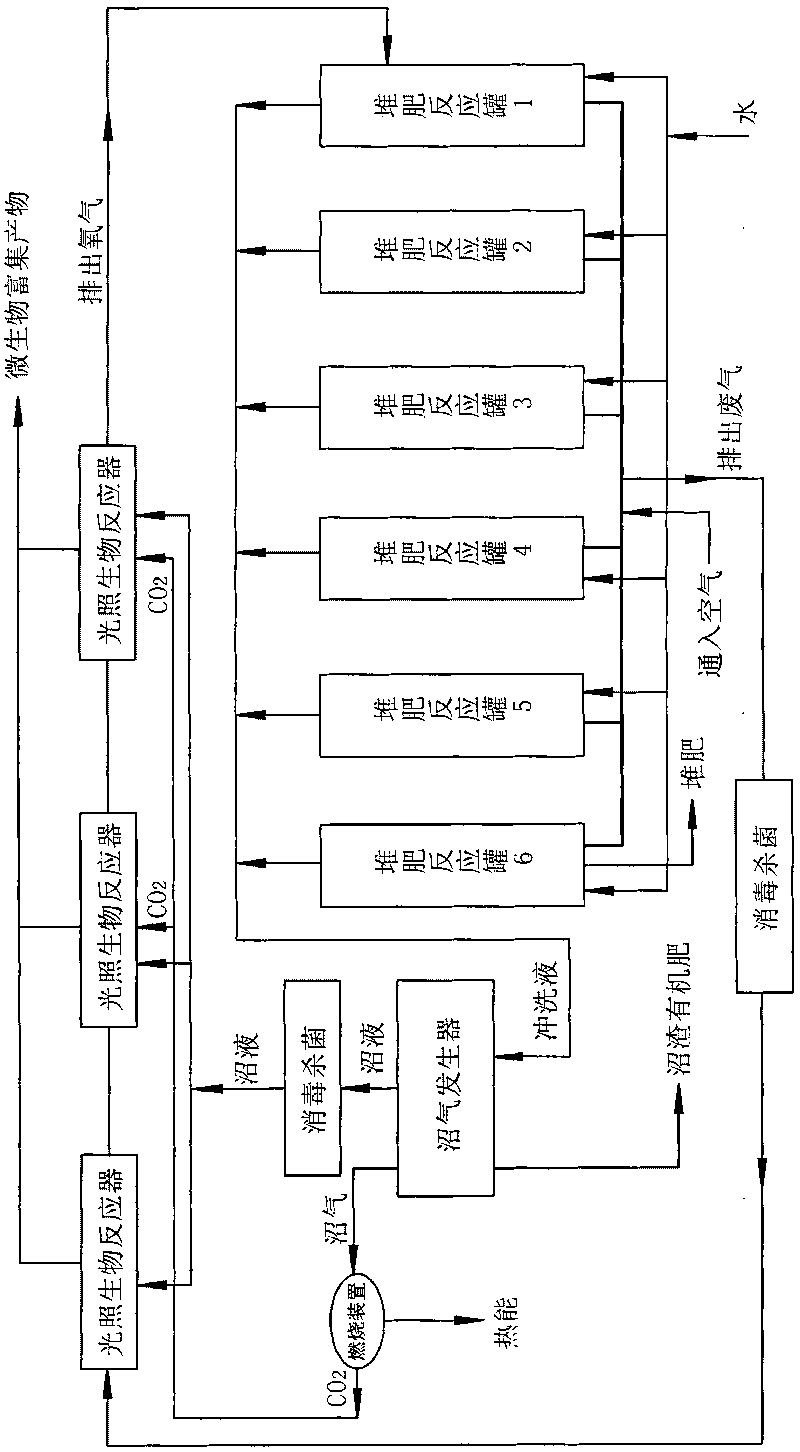Method for efficiently and cleanly disposing solid organic wastes
A solid waste, clean treatment technology, applied in the preparation of organic fertilizers, organic fertilizers, waste fuels, etc., can solve problems such as loss of nitrogen nutrients, and achieve the effects of promoting growth and reproduction, enriching nutrients, and avoiding re-pollution
- Summary
- Abstract
- Description
- Claims
- Application Information
AI Technical Summary
Problems solved by technology
Method used
Image
Examples
Embodiment 1
[0028] The equipment used in this embodiment includes a photobioreactor, a composting reaction tank, a biogas generator, and a boiler.
[0029] There are 6 composting reaction tanks used, which are connected in series with photobioreactors, each 10m 3 , can load 6m 3 . The photobioreactor used is a light-transmitting, airtight glass container, and three photobioreactors are connected in series as a group. A biogas generator and a combustion device (boiler) are connected in series between the light bioreactor and the composting reaction tank.
[0030] process such as figure 1 As shown, the specific method is:
[0031]a> Crush the straw into granules of about 10mm, add pig manure according to the weight ratio of 1:1, adjust the carbon-nitrogen ratio (to control the carbon-nitrogen ratio within 20-40:1), add compost after mixing In the reaction tank, air is passed into the composting reaction tank for 1 hour at an interval of 1 hour, and the ventilation rate is 150 liters / mi...
Embodiment 2
[0034] The equipment used in this embodiment includes a photobioreactor and a composting reaction tank.
[0035] The three photobioreactors in this embodiment are connected in series as one group. The carbon dioxide gas produced by the composting reactor is passed into three photobioreactors respectively through the diversion pipe to provide carbon sources for the growth and reproduction of phototrophic microorganisms. Oxygen produced during the photobiological reaction is returned to the composting tank to provide the composting reaction. Process reference figure 1 .
[0036] Concrete process steps are:
[0037] a> Crush the straw into granular matter of about 20mm, add cow dung to adjust the carbon-nitrogen ratio according to the weight ratio of 1:1.2 (to keep the carbon-nitrogen ratio within 20-40:1), add compost after mixing In the reaction tank, the air is fed into the reaction tank for 1.5 hours at intervals of 2 hours, the ventilation rate is 100 liters per minute, ...
Embodiment 3
[0042] There is one photobioreactor and one composting reaction tank in this embodiment. Process flow can refer to figure 1 .
[0043] Concrete process steps are:
[0044] a> Crush the bean cake into granular substances of about 10 mm, add rice straw to adjust the carbon-nitrogen ratio (to keep the carbon-nitrogen ratio within 20-40:1), mix it and put it into the composting reaction tank, and pass it continuously at the initial stage of operation Air, ventilation volume controlled at 1.0g O 2 / g organic matter——4.0g O 2 / g organic matter. Ferment for 10 days to form compost.
[0045] b> Place chlorella and macroalgae in a photobioreactor, add anaerobic sludge leaching solution (this solution can be purchased from the market), control the water temperature at 25-30°C, and place it for 36-40 hours.
[0046] c> The gas (mainly carbon dioxide) discharged from the composting tank is sterilized and transported to the photobioreactor; when the dry matter concentration of photot...
PUM
 Login to View More
Login to View More Abstract
Description
Claims
Application Information
 Login to View More
Login to View More - R&D
- Intellectual Property
- Life Sciences
- Materials
- Tech Scout
- Unparalleled Data Quality
- Higher Quality Content
- 60% Fewer Hallucinations
Browse by: Latest US Patents, China's latest patents, Technical Efficacy Thesaurus, Application Domain, Technology Topic, Popular Technical Reports.
© 2025 PatSnap. All rights reserved.Legal|Privacy policy|Modern Slavery Act Transparency Statement|Sitemap|About US| Contact US: help@patsnap.com


